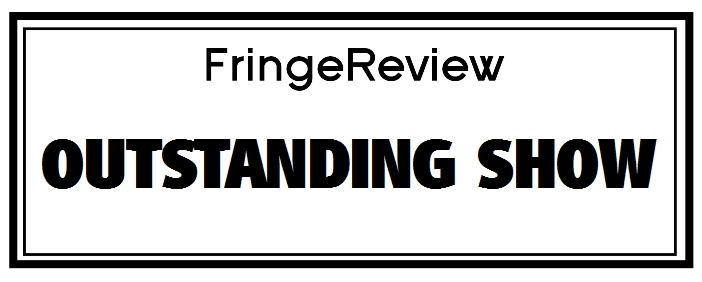Brighton Fringe 2024
The Trials of Magnus Coffinkey
ATK Give or Take Productions

Genre: Contemporary, Drama, European Theatre, Fringe Theatre, International, Live Music, New Writing, Short Plays, Theatrical Clown, Tragedy
Venue: Lantern Theatre, Brighton
Festival: Brighton Fringe
Low Down
A magical tale about magical thinking? Blazoned as “a broken fairy tale for broken people” Malcolm Galea’s The Trials of Magnus Coffinkey navigates grief in a sweep of autumn leaves. Directed by Philip Leone-Ganado it plays at the Lantern Theatre till May 19th.
Of the 115 (mostly London) shows I’ve seen this year so far, it ranks as the most profound, and one of the very finest.
Written by Malcolm Galea, Directed by Philip Leone-Ganado, Set Design and Costume Design by the Cast, Lighting and Sound Direction, Production Stage and Tech Designer Erin Burbridge.
Till May 19th
Review
A magical tale about magical thinking? Blazoned as “a broken fairy tale for broken people” Malcolm Galea’s The Trials of Magnus Coffinkey navigates grief in a sweep of autumn leaves. Directed by Philip Leone-Ganado it plays at the Lantern Theatre till May 19th.
The trial here is one of endurance and agility. A man, Magnus (Joseph Zammit) climbs an impossibly high tower. He’s going to fix a broken bell with a hammer: the sound echoes. A mahogany cabinet serves as tower foundations, a few hats and gargoyle masks peer up. At one level the parti-coloured jacket and masks look so Grimm they’re grim, at another level there’s nothing fabulous: at 3.43 am the world changed.
No, the world ended. Lara (Becky Camilleri) pops up as several gargoyles. Ones nearer the top are younger built later, “obviously”, but just as irritating one states, just more cheery. That turns out true. They’re horribly truthful. They tell Magnus he’ll fail to replace the bell. But once a century if you manage to do this, on this night, your greatest wish comes true.
It’s love, but a particular kind. The love whose measure is loss. They might be in motley, but these aren’t the tears of a clown. There’s singing: cracked-bell, or bell-like, but broken.
What Magnus doesn’t heed – despite warnings he brushes aside – are bats. He crashes to earth and should be dead, in suspension. Well he is but trapped inside a holy bell on the ground, he’s in Limbo.
So is this buzzy happy person with frizzy hat and voice. Someone warm-hearted, whole-hearted: he calls her Harmony. Eventually he gifts half his broken heart to her. Or even breaks it in two again when she seems to mend it.
The story sashays in and out, as the real couple Magnus and Lara look at each other and ask if they can go on enacting this. Naturalistic dialogue, a drop of comedic gremlin-speak. Just grief. Late on, an offstage voice. Terribly compassionate.
When Magnus returns it’s having been resurrected but leaving Harmony behind, which he finds he can’t do, especially when she offers half her heart. This is where Camilleri enacting all the neighbours offers odd help: like sticking half a bread bun into his heart, but they’re too hot. Only another neighbour has half a heart, Lara again. They commiserate,
Returning yet again, Magnus finds all the villagers are devastated by the total loss of the bell and with bits of gargoyle ruining everyone’s gardens, are no longer minded to anything. Gradually Magnus works some magic.
What we’re seeing is Everyman and this play invests the same mythic power, with a simple devastation straight out of the 15th century. “Death thou comest when I had thee least in mind” as Everyman then tries to recruit neighbours to accompany him on his last journey. A play that can invoke Everyman without trying reaches an utterance denied to most of us.
The grief is a stillborn child, whom Magnus has named Harmony. Quite how they navigate an absolute loss which can never be assuaged is one of the miracles of a play that offers no release out of the circle of magical thinking. Not even resurrection, the resort of some. “I’ll never trust my body again” states Camilleri.
“For what can you say to someone when their heart’s been cleft in two?
Nothing…
Nothing…
Nothing…
No words will ever do.”
The use of fairy-tale rhyme and narrative verse heightens both ritual and the timeless mythic element, but links theatre-making to its most elemental: a poetics of extremes.
Both Camilleri and Zammit are outstanding. The tears on their cheeks are real. They give everything depicted here – real or fantastic – a truth so intense you imagine they’ve lived it personally.
There’s no individual credit given to props or lighting, presumably the company’s: but production stage and tech designer Erin Burbridge deserves much credit for cues and sensitive transitions; and if she designed this rig, even more.
This 80-minute Give or Take Production from Malta is the most devastating piece of theatre I’ve seen not only at this Fringe, but most others too. Of the 115 (mostly London) shows I’ve seen this year so far, it ranks as the most profound, and one of the very finest. Only one other Fringe show I’ve seen approaches it, Andrew Cusack’s Magpie, given in the same space. Both are outstanding, but this breaks things.


















































